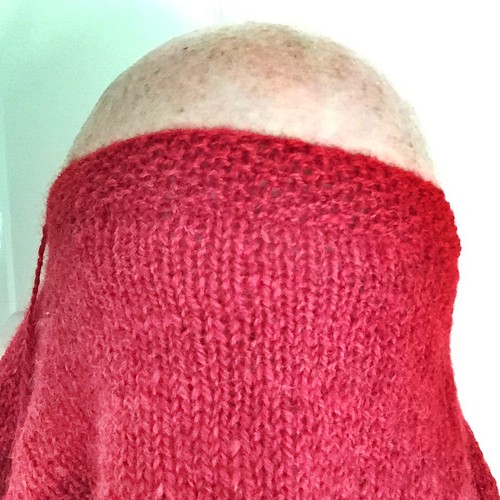This past month (well one month and one day), I've been working on a striped sweater using yarn handspun by Janelle. It's finished!
While visiting Gettysburg this past summer, I got to admire all the amazing handspun yarn that she's made over the years. Noting that she couldn't knit it all, she said I could take a batch of whatever I want. Janelle's palette runs decidedly blue/green, so this batch of cranberry red yarn really jumped out! We both knew it wasn't enough to make an adult sweater, but she suggested that maybe I could work in another color in some way to stretch it out. After I got back to Texas I bought some in Brooklyn Tweed Loft in a grayish-brown called Barn Owl, and this is what I came up with.
I'm using the general crew-neck raglan pullover recipe as outlined in Ann Budd's The Knitter's Handy Book of Sweater Patterns. I've had this book for years, and it's a great go-to source for when you want to branch out on your own in knitting a sweater, but still need to fall back on well thought-out formulas for increasing and decreasing and just general fit.
I couldn't quite get gauge for the 44" in sweater size I wanted to make. But I followed Ann Budd's instructions for adjusting gauge. I ended up using the instructions for the 40" sweater, but following the lengths described in the 44" sweater and it worked like magic! I didn't get quite the ease I wanted, but that's a different type of math, involving adjustments to exercise frequency and taco consumption. Ahem.
I needed to insert the contrasting color in some sort of interesting way, but wasn't sure how. I knew from other design things I've perused that the Fibonacci sequence often produces eye-pleasing results, so I played around with a spreadsheet, adjusting strips and measuring row-gauge, before coming up with a plan. I skipped the number 1 and came up with alternating rows of red and gray/brown yarn in the following sequence: 2-3-5-8-13-8-5-3-2. That is, after 1/3 of the sweater being knit in red, I started with two rows of brown, two rows of red, three rows of brown, three rows of red, etc. Originally, I thought that the top 1/3 of the sweater would be brown, but I decided I had enough to make the top red, and I think it looks much better that way. I did the sleeves the same way, and they more or less match. I like how from a distance, it looks as if you're looking down on a striped cylinder. It also give a sense of motion if I squint just right.
The cuffs, hem and collar are all done in 8 rounds of seed stitch. I love seed stitch, and one day I'd like to make a sweater that is entirely of it. This stitch made a good edge for the most part, although the hem still tends to curl up when I'm not wearing it. It seems to behave once it's on me. I did have an issue with the bind-off. Traditional bind-offs are notorious for forming a tight, inflexible ridge, which can cause problems getting garments on and off. I thought that going up a couple of needle sizes would take care of that, but as you can see, it wasn't enough. I probably could have tugged it down over my ears and nose, but I wasn't confident I would be able to ever remove it. So I undid the bind-off, put the stitches back on the needles, and used Staci's sewn tubular bind-off. It's very easy, I think, and although the directions are for 1x1 ribbing, seed stitch is basically a variation on that and it seemed to work just fine.
Although it's made of alpaca and wool, I was surprised how un-hot I was in it in our low-80s temperatures when we went to the back yard to take some pictures. The main problem was all the mosquitoes that have appeared since our copious Harvey-related rain. I can't wait until it cools off a bit so that they all go away, and I get to wear my new sweater.


